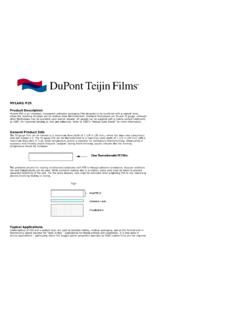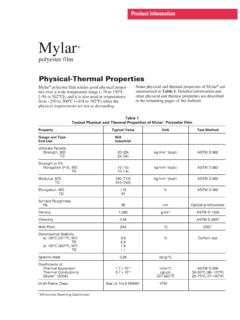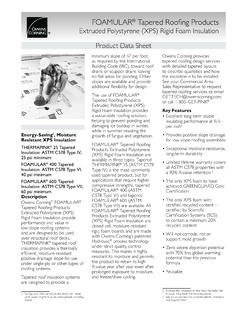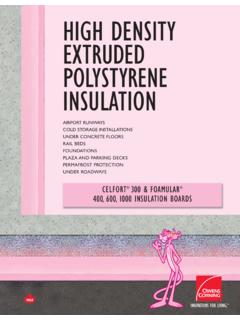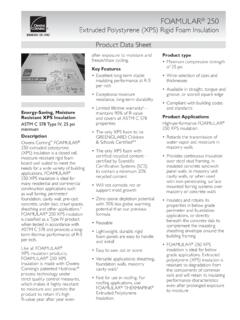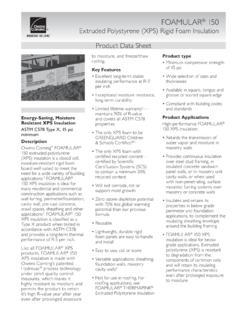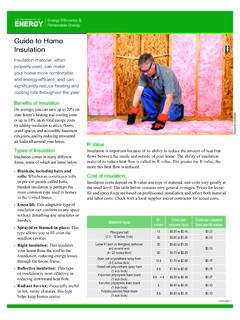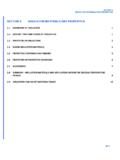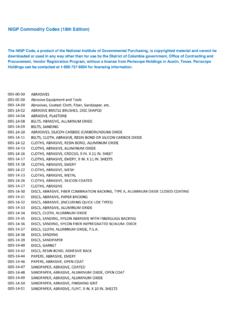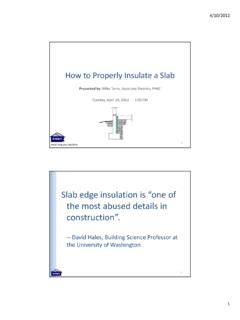Transcription of Product Information - DuPont Teijin Films
1 Product Information Mylar . polyester film Electrical Properties Mylar offers unique design capabilities to the Electrode Size electrical industry due to the excellent balance of Differences in dielectric strength values may result its electrical properties with its chemical, thermal, when comparing 1/4 in and 2 in diameter brass and physical properties. Detailed descriptions of electrodes. Because of the larger film area between these latter properties are included in other avail- the electrodes, the potential for lower dielectric able bulletins. Table 1 is a summary of some strength values is greater with 2-in electrodes. typical electrical properties; further details on these and other electrical properties are included in the remaining pages of the bulletin. Figure 1. Dielectric Strength vs. Thickness (2 in Electrode in air at 25 C [77 F]).
2 Dielectric Strength 40,000. The short-term dielectric strength test (ASTM 30,000. D149) is primarily used to measure the quality of a film. This test method allows considerable freedom 20,000. in the choice of electrode size, environmental Dielectric Strength, V/mil conditions, etc. The following discussion of these variables is based on tests run with brass electrodes 10,000. of the dimensions prescribed in ASTM D2305. In 8,000. limited testing, stainless steel electrodes gave 6,000. results similar to those obtained with the standard brass electrodes. The data were obtained at a 4,000. frequency of 60 Hz, using a 500 V/sec rate of rise, 3,000. unless otherwise noted. 2,000. Film Thickness As with most materials, the AC Dielectric Strength 1,000. of Mylar polyester film in V/mil decreases as film 14. / 1/2. 1 2 4 6 8 10 14 20.
3 Thickness increases (see Figure 1). At 500 V/sec Thickness, mil rate of rise, corona occurs within a few seconds, and the film begins to melt before the actual breakdown occurs. The greater the film thickness, the more the failure is due to melting and, thus, the lower the V/mil as thickness increases. Table 1. Typical Electrical Properties of Mylar Polyester Film Property Value Test Method DC Dielectric Strength Typical Value for Mylar 92 EL/C*. 1. 25 C (77 F) kV/mil / 4 in upper electrode and flat plate lower electrode. 500 V/sec rate of rise Gauge and Type at 25 C (77 F) Minimum Values for Mylar C Film 6C kV Minimum average 7C kV voltage of 20 film-foil 8C kV capacitors, F each 10C kV. 12C kV. 14C kV. 20C kV. 24C kV. 32C kV 100 V/sec rate of rise 40C kV. 48C kV. 75C kV. 92C kV. AC Dielectric Strength Typical Value for Mylar 92 EL/C*.
4 25 C (77 F) kV/mil ASTM D149 and ASTM D2305. 60 Hz 500 V/sec rate of rise Gauge and Type at 25 C (77 F) Minimum Values for Mylar EL Film 48EL kV ASTM D149 and D2305, 75EL kV Minimum average 92EL kV voltage of 10 sheet 142EL kV samples 200EL kV. 300EL kV 60 Hz 500EL kV 500 V/sec rate of rise 750EL kV. 900EL kV. 1000EL kV. 1400EL kV. Dielectric Constant Typical Value for Mylar 92 EL/C*. 25 C (77 F) 60 Hz ASTM D150. 25 C (77 F) 1 kHz 25 C (77 F) 1 MHz 25 C (77 F) 1 GHz 150 C (302 F) 60 Hz Dissipation Factor Typical Value for Mylar 92 EL/C. 25 C (77 F) 60 Hz ASTM D150. 25 C (77 F) 1 kHz 25 C (77 F) 1 MHz 25 C (77 F) 1 GHz 150 C (302 F) 60 Hz 269 C ( 452 F) 1 kHz (in Helium) Volume Resistivity Typical Value for Mylar 92 EL/C. 25 C (77 F) 1018 ohm cm ASTM D257 and D2305. 150 C (302 F) (Type C Film) 1013 ohm cm Surface Resistivity 23 C (73 F) 30% RH 1016 ohm/sq 23 C (73 F) 80% RH 1012 ohm/sq insulation Resistance 35 C (95 F) 90% RH 1012 ohm Capacitor insulation Typical Value for Mylar 92 C.
5 Resistance 100 C (212 F) 30,000 M - F Based on F film- 125 C (257 F) 1,000 M - F foil capacitor sections, 150 C (302 F) 100 M - F using single layer, 92. Mylar C. *Data relevant for other types of Mylar . 2. Temperature Figure 3. Dielectric Strength at Various Humidities The effect of film temperature on the dielectric strength of Mylar polyester film is shown in 10,000. Dielectric Strength, V/mil Figure 2; there is a slight decrease in dielectric 8,000. strength from room temperature up to 150 C 20% RH. (302 F). 6,000. 80% RH 35% RH. Figure 2. Dielectric Strength vs. Temperature 4,000. 8,000. 7,000 2,000. mil 1 2 3 4 5 6 7 8 9 10. Dielectric Strength, V/mil Thickness, mil 6,000. 5,000. 2 mil 4,000. Frequency and Wave Form The DC dielectric strength of Mylar 92 EL varied 3,000 from 14,000 V at 25 C (77 F) to 12,000 V at 90 C.
6 Mil (194 F), 8,000 V at 150 C (302 F), and 5,500 V. 2,000 at 200 C (392 F). These data were obtained with a 1. / 4 in upper electrode and a flat plate lower elec- 1,000 trode using a 500 V/sec rise. Deviations from a sinusoidal wave form can have 0 marked effects on the measured dielectric strength 0 25 50 75 100 125 150. (32) (77) (122) (167) (212) (257) (302) at power frequencies. To simulate the effect of Temperature, C ( F) transients, impulse strength tests were run using 40 sec square wave forms and subjecting specimens to five pulses at each voltage. (The voltage was increased by several hundred volts Humidity between each set of pulses.) The average impulse While the dielectric strength of Mylar is much less strengths were 22 kV for Mylar 300 EL polyester sensitive to the humidity of the surrounding air than film and 26 kV for Mylar 1000 EL when the cellulosic materials, there is a slight effect as shown samples were tested in air.
7 In Figure 3. For Films above 2 mil thick, the effect of varying the relative humidity from 20 to 80%. causes a maximum change in the dielectric strength of less than 10% from the value obtained at 35%. RH. The absolute differences in dielectric strength as a result of humidity changes appear to be inde- pendent of electrode size. 3. Corona Threshold Voltage continuous operation is contemplated at AC volt- AC corona, an ion bombardment that causes ages above those shown in Figure 4. In such cases erosion of a material, is not observed with Mylar suitable impregnation, by gas or liquid, can result in polyester film at AC voltages under the curve of substantial increases in the AC corona threshold corona threshold voltages plotted in Figure 4. In voltages. For example, values as high as 4,000 V. this case, threshold voltage means the level below rms have been attained with an oil impregnated which corona is not observed at all either as a capacitor that was insulated with 3-mil Mylar.
8 Starting or extinction voltage. These values were Dielectric Constant obtained with unimpregnated systems in air, with There is no significant difference in dielectric sharp edge electrodes, at 60 Hz. Most AC systems constant between Type EL and Type C Films . are designed so that corona is not continuously present. However, the corona resistance of Mylar . is one of the highest of all plastic Films . This makes Temperature it capable of withstanding the corona that may At a constant frequency, the dielectric constant occur during the short surges of overvoltages increases as temperature of the film increases above common to many electrical systems. 65 C (149 F) as shown in Figure 5. Figure 4. AC Corona Threshold Voltage Figure 5. Dielectric Constant vs. Temperature 1,400. 1 kHz 1,200. 1,000. Dielectric Constant 800. V, rms 600.
9 400 Mylar 24 C. 200. 0 0 1 2 3 4 5 6 7 8 9 10. Film Thickness, mil 0 20 40 60 80 100 120 140 160. (32) (68) (104) (140) (176) (212) (248) (284) (320). Temperature, C ( F). In DC systems, corona is seldom of any practical concern. For systems involving both AC and DC, such as a capacitor with a DC bias and an AC. component, it is primarily the AC that governs corona. That is, whatever the DC working voltages may be, AC voltages approximately equal to those shown in the curve must be added to the DC before corona is observed. Impregnation is required for insulation systems that are to be operated continuously at AC voltages above their corona threshold in air. Porous materi- als, such as paper and cloth, usually require impreg- nation to attain suitable corona levels. Mylar , however, requires no impregnation at all, unless 4.
10 Frequency Figure 7. Dissipation Factor vs. Temperature At a constant temperature, the dielectric constant decreases as the frequency increases, as shown in Figure 6. Mylar 24 C. Figure 6. Dielectric Constant vs. Frequency 100 kHz Dissipation Factor, %. Mylar 24 C Dielectric Constant 1 kHz 125 C (257 F) 100 Hz 0. 0 20 40 60 80 100 120 140 160. 25 C (77 F) (32) (68) (104) (140) (176) (212) (248) (284) (320). Temperature, C ( F). 75 C (167 F). Figure 8. Dissipation Factor vs. Frequency 102 103 104 105. Frequency, Hz Mylar 24 C. Humidity Tests on flat sheets and unencapsulated capacitors 25 C. (77 F). showed that the dielectric constant (at 100 Hz and 150 C. 1 kHz) of Mylar polyester film increased by 3% as (302 F). the relative humidity at 23 C (73 F) increased from 125 C. Dissipation Factor, %. 20 to 80%. Suitable encapsulation can greatly (257 F).
